

How it´s done – a Yacht Test
- May 29th, 2019
- On Location
Do you have a monthly subscription for a sailing magazine? I mean, not your regular click on no-frills-sailing.com (of which I am very grateful and proud) but I mean the printed issues of the well-known yachting magazines. I do not have but only because I “have” to have those magazines because of my job. It´s a weird fact but in times of digitalization and the decline of printed “real” stuff the sailing magazines are still around and some of them are enjoying a wide range.
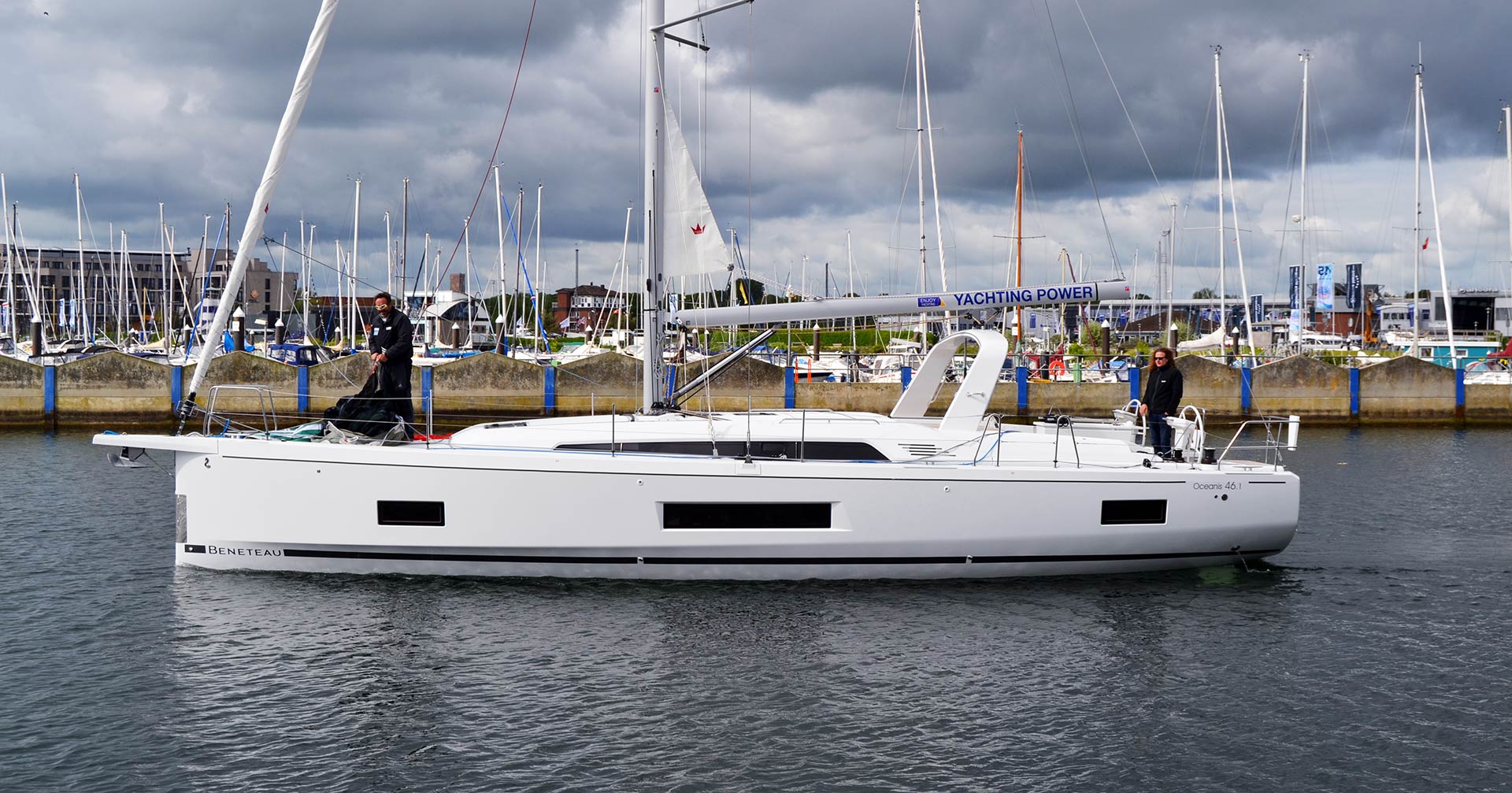
The last days one of these magazines, Europe´s largest yachting magazine, the German “Yacht”, was conducting a big and costly test. As I am part of the Beneteau dealer´s network our newest member of the fleet, the Oceanis 46.1 was selected to take part. Our fleet has been joined by a Bavaria C45 and the Hanse 458, comprising a three-boats test. Jeanneau couldn´t provide a boat for the test as well as Dufour. So I was very excited to being part of this venture and witness such a big test of the 46-feet-class first hand.
The aim of a sailing yacht test
First of all, my aim of this article is neither to convince you dear reader that the Oceanis 46.1 is the best boat of them all – we all know that yachts are always a compromise between so many things and each boat or brand may have strengths and weaknesses in one way or the other. My aim is to show you how the “Yacht” Magazine was conducting this 3-day-test so that you may gain some insight in how it´s done. If you are interested in the very test of Hanse vs. Bavaria vs. Beneteau, you might get a copy of the issue of “Yacht” when the article is published in a few weeks time.
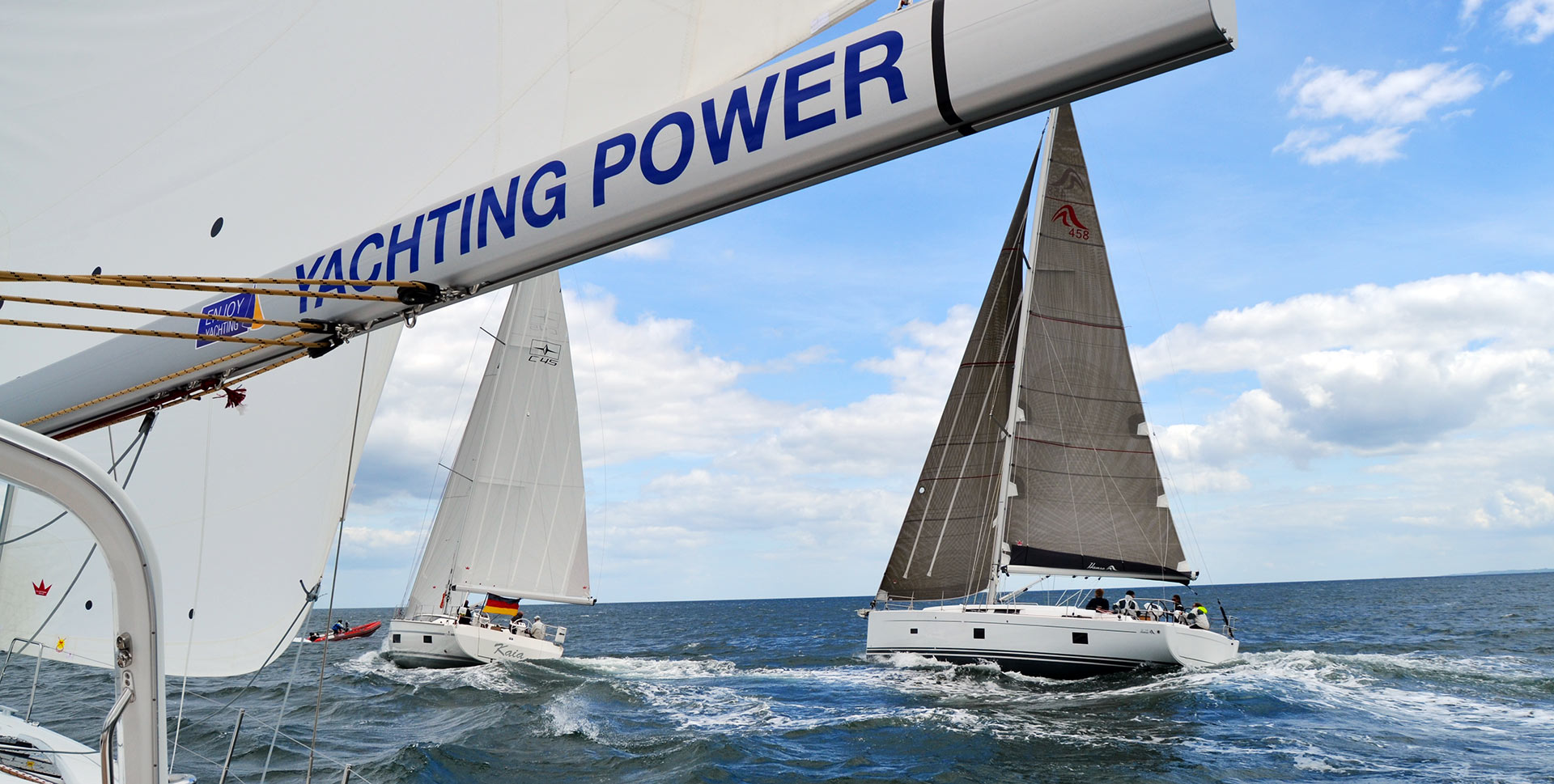
I was keen on getting to know what the purpose of this test was. As the “Yacht”-crew was telling me, it was to show how each boat performs in a broad variety of different angles from which the team was looking onto the boats. Of course, the performance under sails was one major part, sure, but they also looked at the interior, took extensive measurements of all aspects of the boat like berths-sizes, headroom and so on, they had a specialist coming one day who was solely looking at electric installations , one for engines and power generation, one for the interior and building quality and so on. So, as the editor-in-chief told me: “… that the reader may in the end get a broad and full picture of what the boat´s character was.”
Let´s go sailing – a three day yacht test
As the two other boats arrived, we met on the jetty very early that day: Sailing time! There was a good chunk of wind coming in from the West and the photographer of “Yacht” was happy about a perfect lighting situation. That was the first thing I´ve learned: The expenditure in team-size by the magazine. Where other press-dates with tests which I´ve done so far had been done by one or two persons, “Yacht” was arriving with a full complement of 6 people! The team was lead by “Yacht”´s editor-in-chief Fridtjof Gunkel and Michael Good, two very experienced sailors and maybe the spearhead of German yachting journalism.
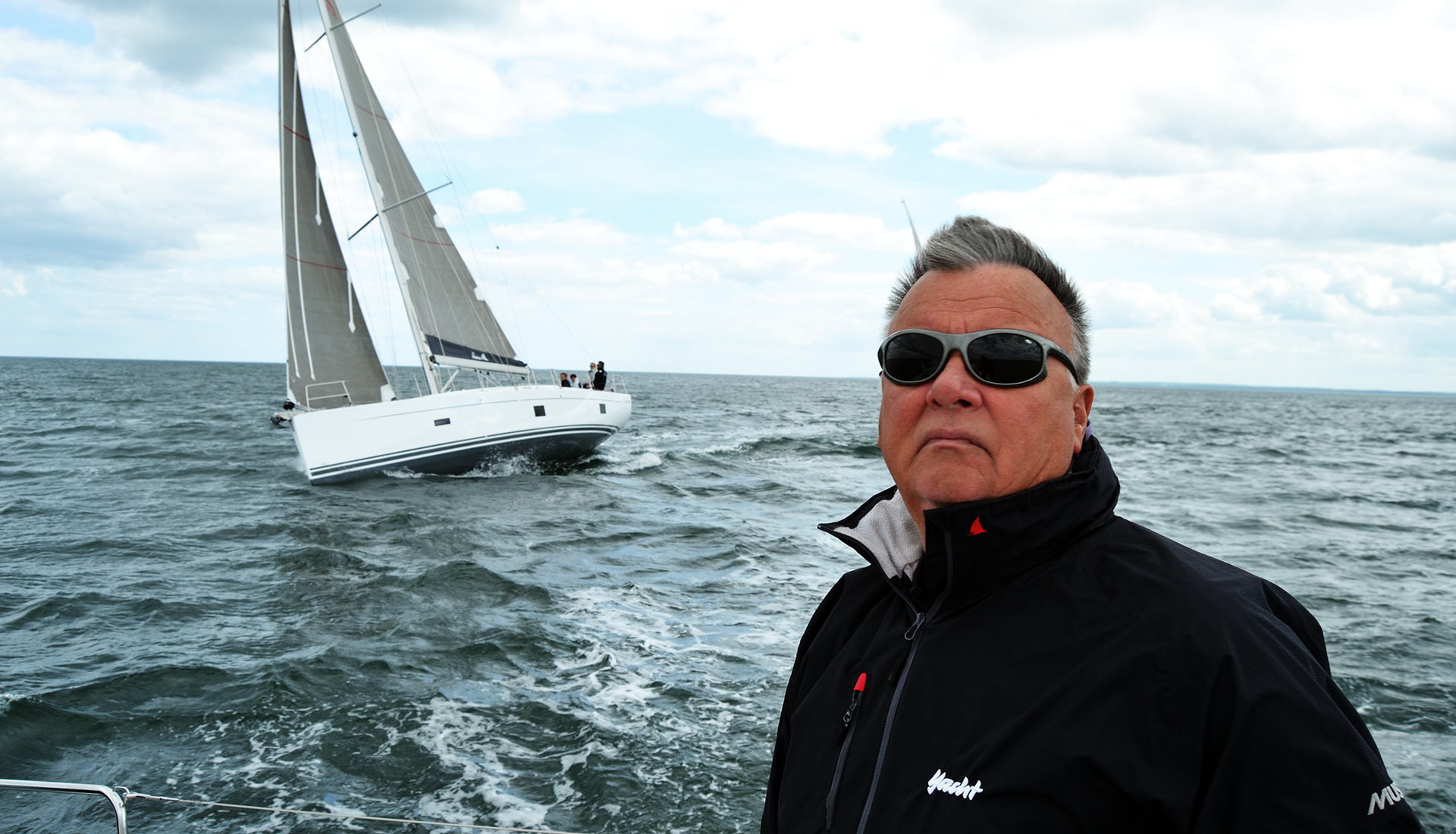
The boats went out of the marina and off we went. We started with having Fidtjof Gunkel aboard who was taking the helm and appeared to me very introvert and concentrated when he was steering the boat. The other two boats had been manned by another “Yacht”-editor each and we sailed on for one or two hours. The program was easy: Running downwind for a while, the luffing to extreme close hauled and going upwind again. Fridtjof didn´t take any notes but judging from his occasional comments he was clearly completing a multi-staged check with testing the boats on the various points of sail.
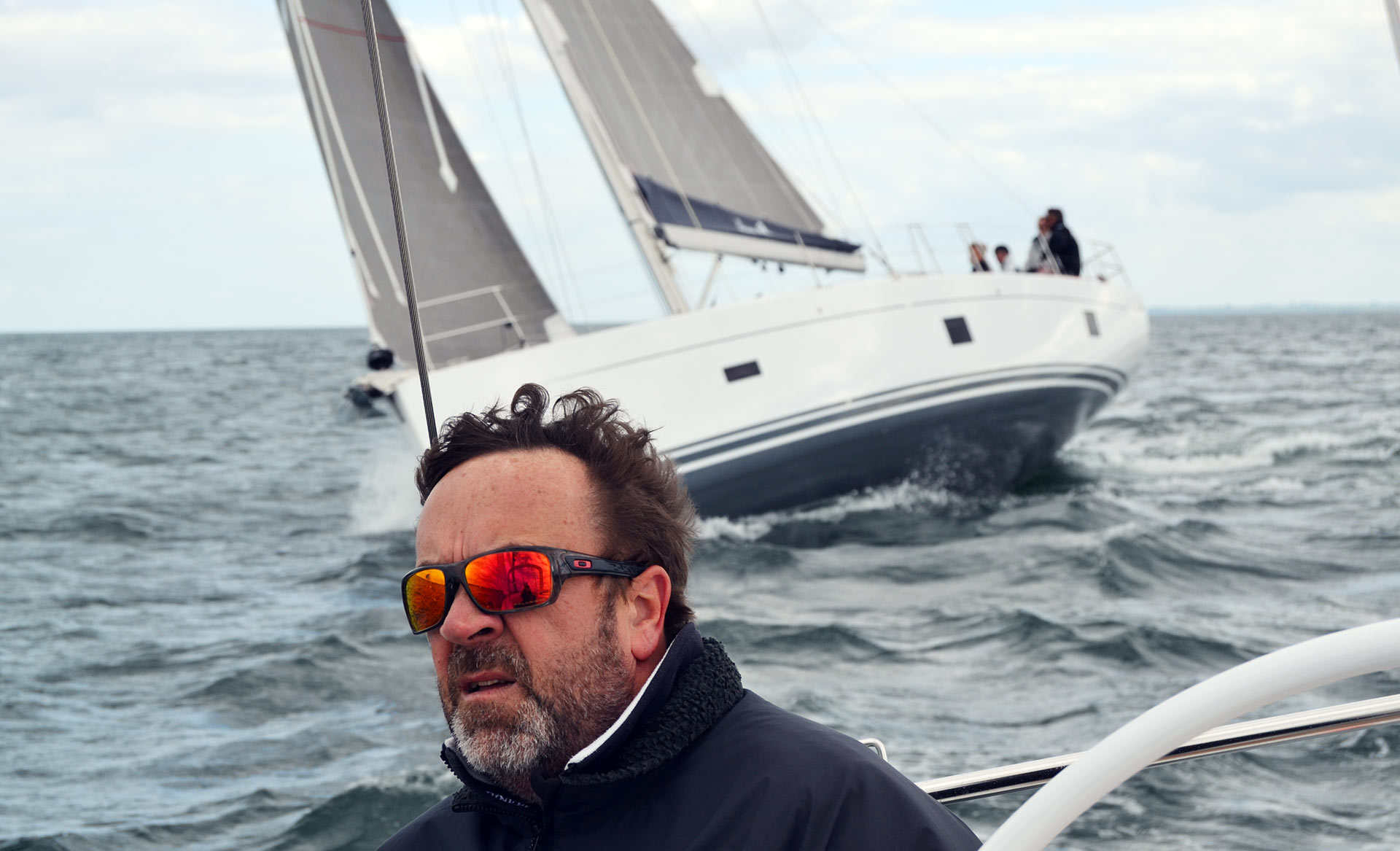
When we were preparing the test occasion we decided to hire pro-sailor Tim Kroeger to act as sailing counselor for our boat because we knew that – of course – each of our “contenders” would be also trying to stage a perfect performance for their boats. That meant that on the Bavaria a Danish well-known Elvstroem-pro was accompanying the crew and on the Hanse the Sales Director himself was commanding the vessel. For us, Tim Kroeger was the perfect choice: Not because he is a world-class sailor, but because he is one of the few pro-sailors who understand the production boat market.
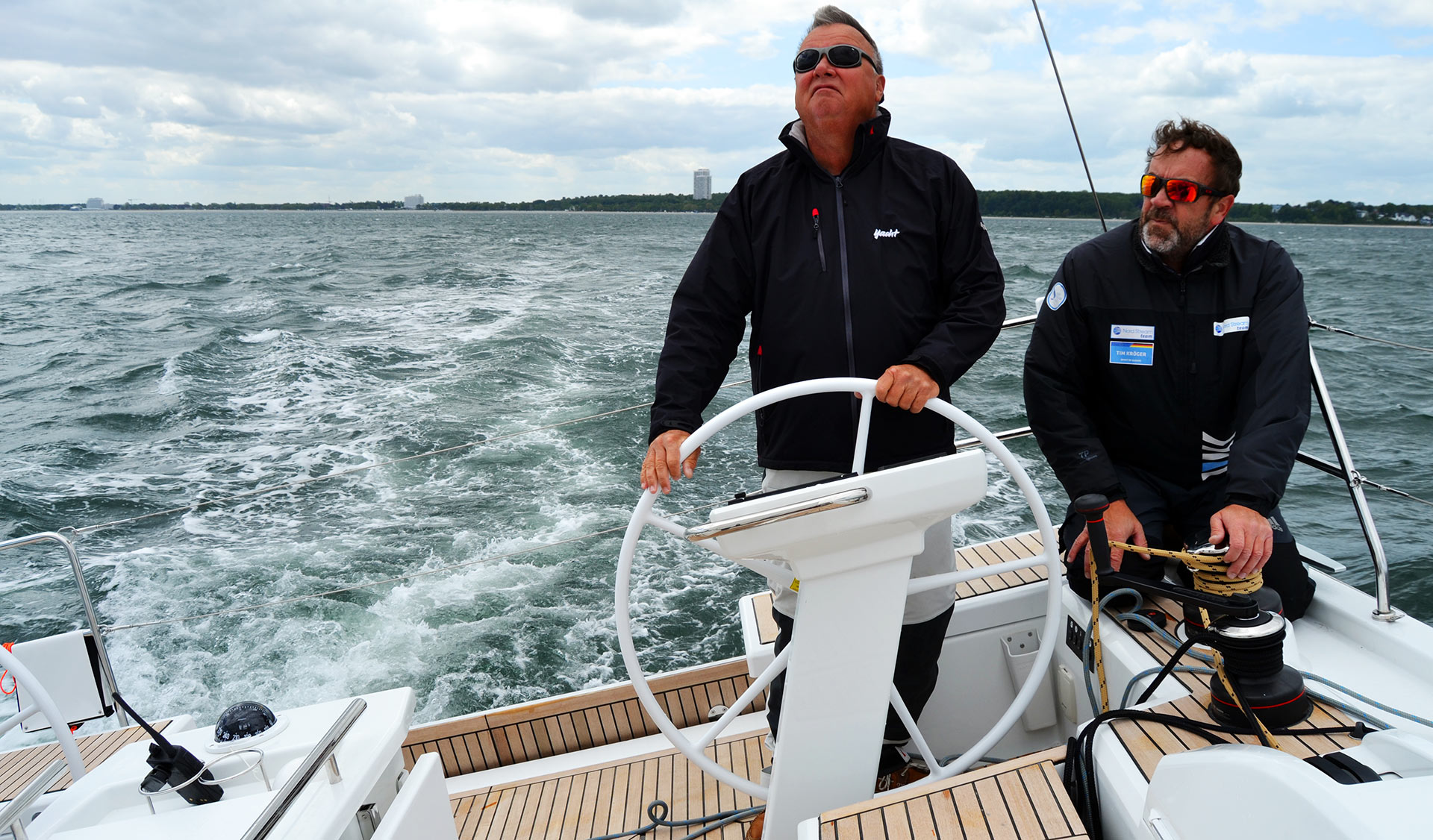
As he was putting it: “Production boats will never have the performance of a thoroughbred racing yacht. They are not intended to. Most if not all of the people who own one of these will ever take these boats to their limits – but I think it is important to show what these boats can do and where their limit is set.” This in mind, we were knowingly fitting our Oceanis 46.1 with standard Dacron sails and an in-mast furling mainsail: “It´s this configuration that is sold primarily. People may dream of high performance laminate-sails but reality is that most of them are sailing standard sails.”, says Tim. And we agree: Putting on high-end sails may have meant nicer pictures for the magazines and surely a better performance but would it provide credible and useful information for the readers?
Elaborate testing
So we sailed up and down the whole day. The due process of the test was interesting to observe: After nearly a full hour at the helm, one of the three editors would call by VHF the rib to come in. Seconds later a fast outboard boat dashed from abaft and he would leave the boat. Again, five minutes later the rib arrived back with another editor of “Yacht” boarding our boat with a wide grin in his face saying: “Here I am, let´s sail!” And again, one hour of sailing.
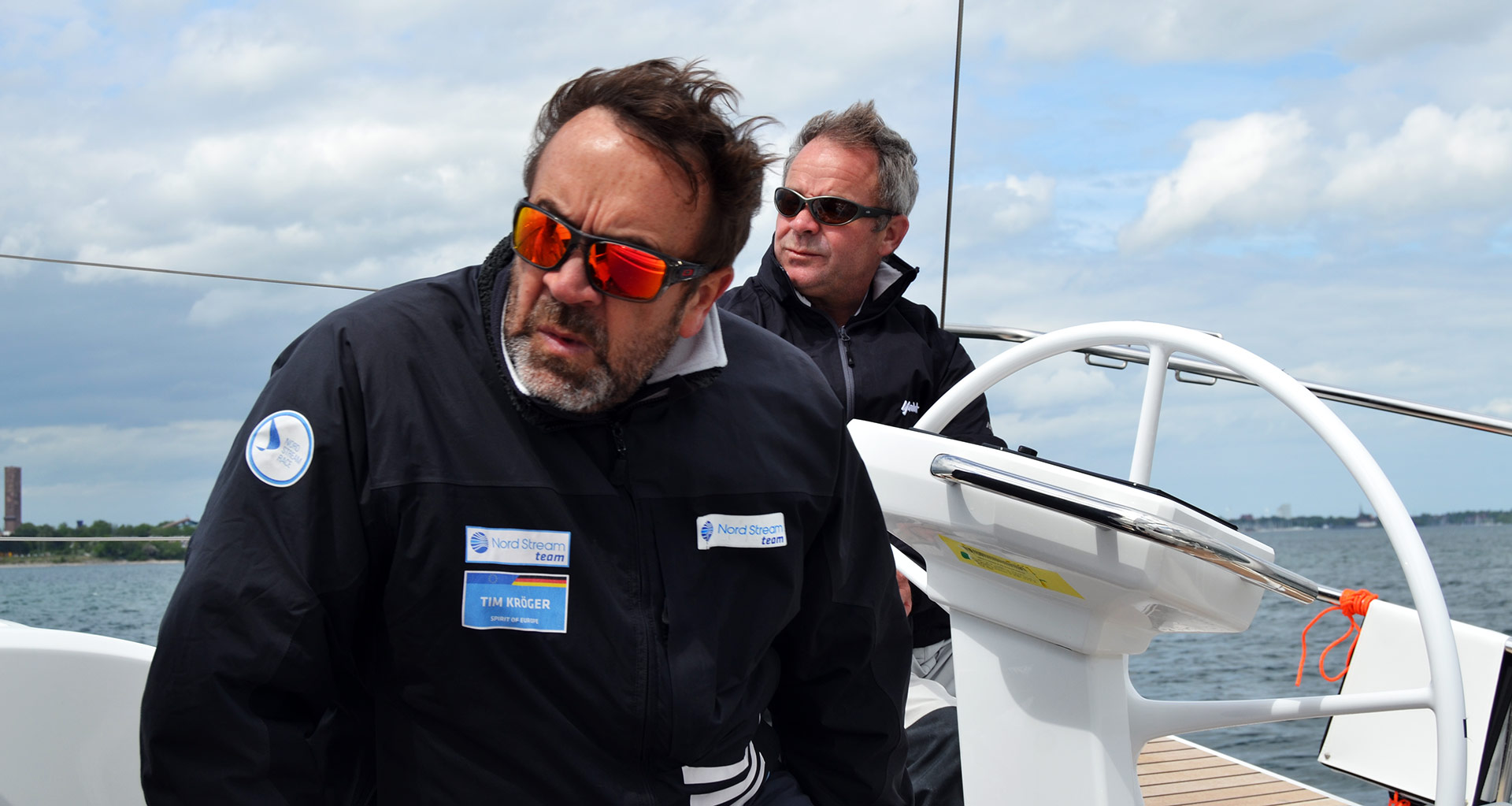
The procedure was interrupted occasionally by the VHF announcing the lead photographer´s instruction that all boats may be lining up in a determined order so sail on a determined point of sail for a couple of minutes alongside: Time to shoot the cover picture. That was the most exciting part of it all, having Bavaria and Hanse in two arm lengths sailing close by. Harder was the part to match our speeds, because both boats did have higher quality sails with the Hanse bearing a performance rigging with a higher mast and much more sail area . Nevertheless, we managed to do it and I am sure the article will later be bristling with great pictures taken that day!
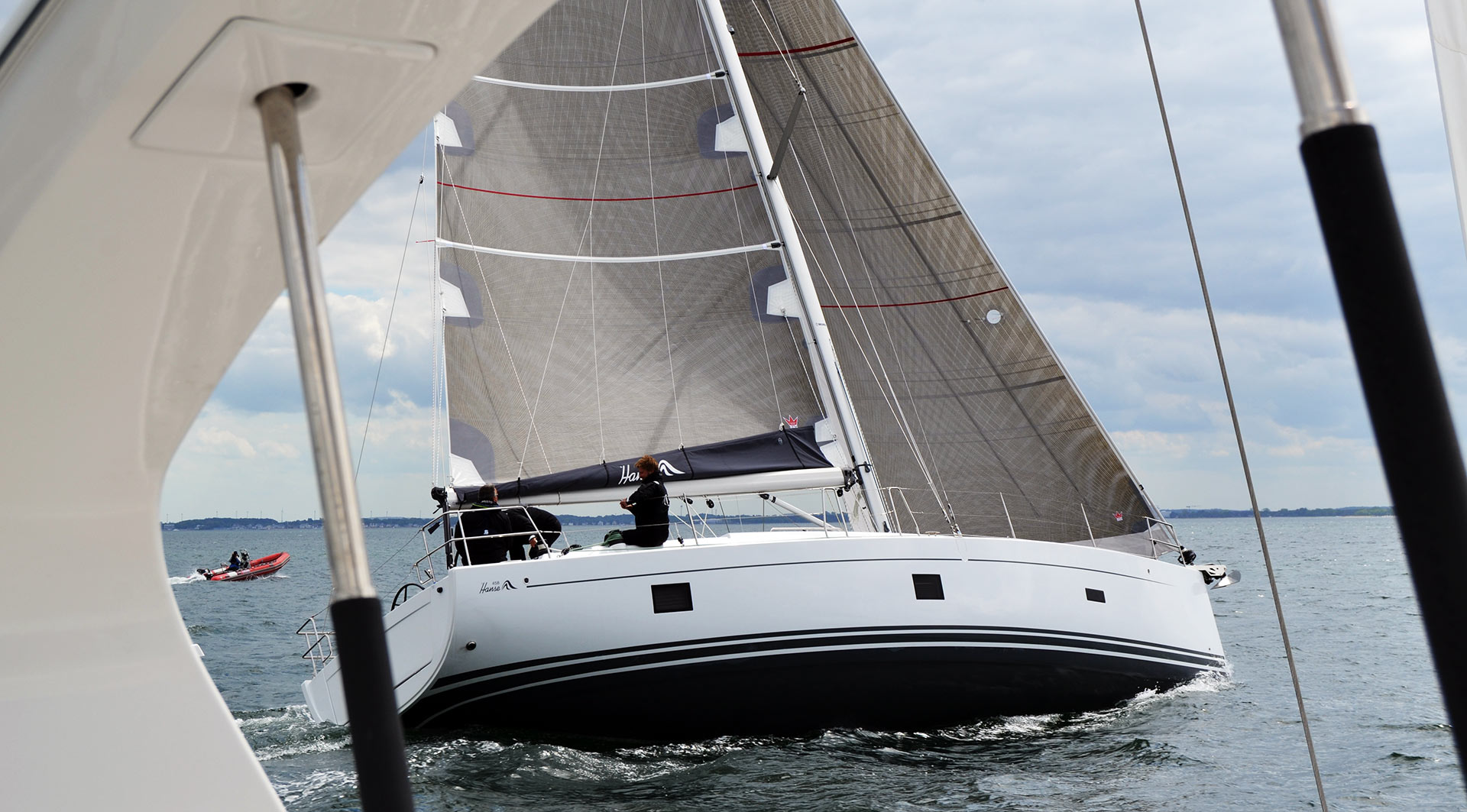
It was also interesting for me to observe how the boats behaved on different points of sail and how the hulls went through the water. Whereas the Hanse is undeniably a very good performing sailing boat upwind (especially with her high powered rig and adorable laminate sails) the Bavaria did maintain a considerable performance under battened furling-main. I could clearly sense the differences between these three boats – upwind- and reaching-optimized boats, full internal volume vs. sleek and chic design, wide open low transoms versus narrow beams. You rarely get to see this in real life that often.
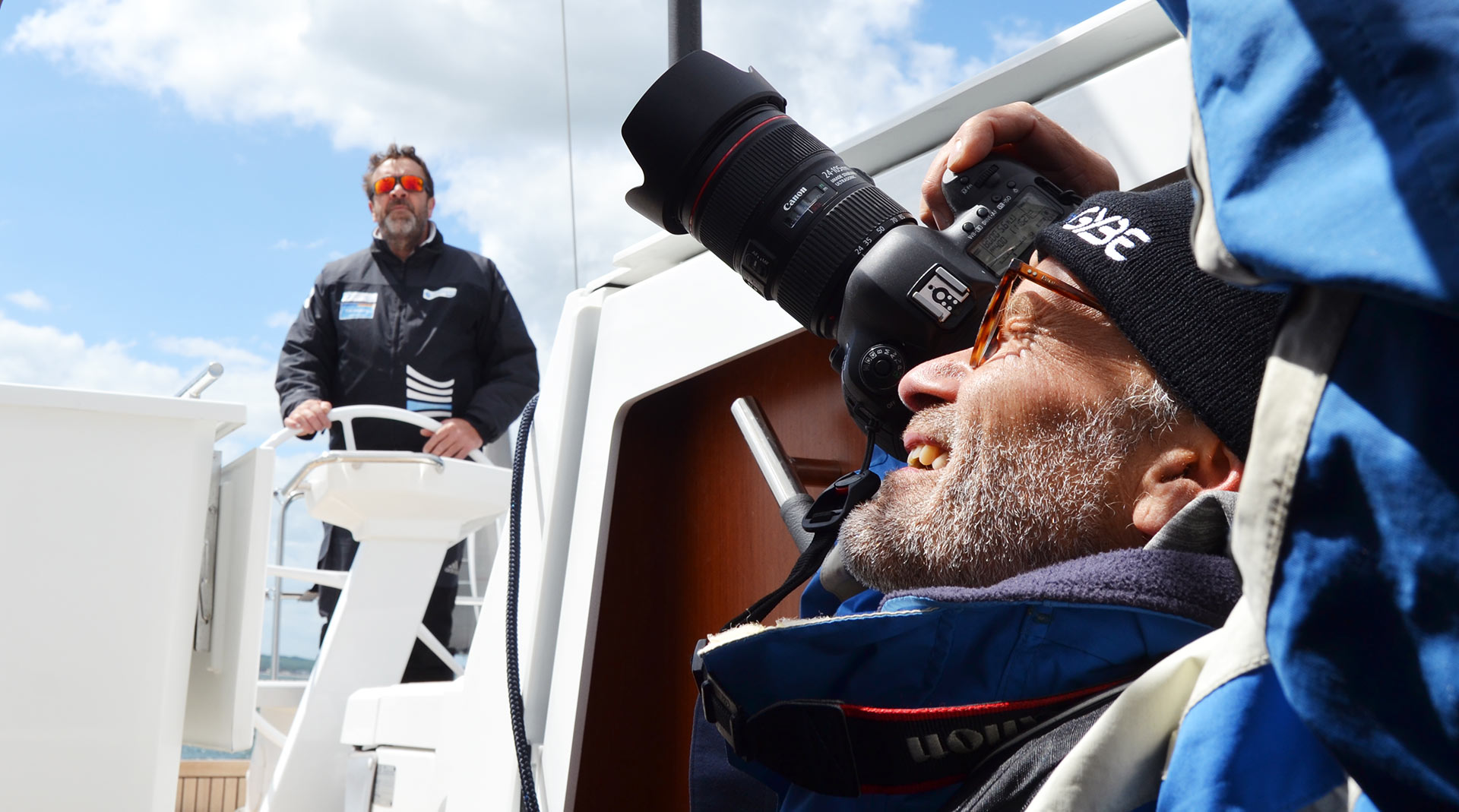
The photographer did an amazing job as well! He was helming the rib dashing in between the boats and seconds later he would jump aboard to take tons of pictures of the boat, details of the sails and rigging only to leave and steer the drone humming over our eyes minutes later. The other day they winched him up high in the mast so that he may take pictures of the boats from bird´s eye perspective just to see him crawling the engine room and sails locker for another detailed shooting of the boat´s properties. A tough job but he was smiling all the time, always ready for a quick joke. Great guy!
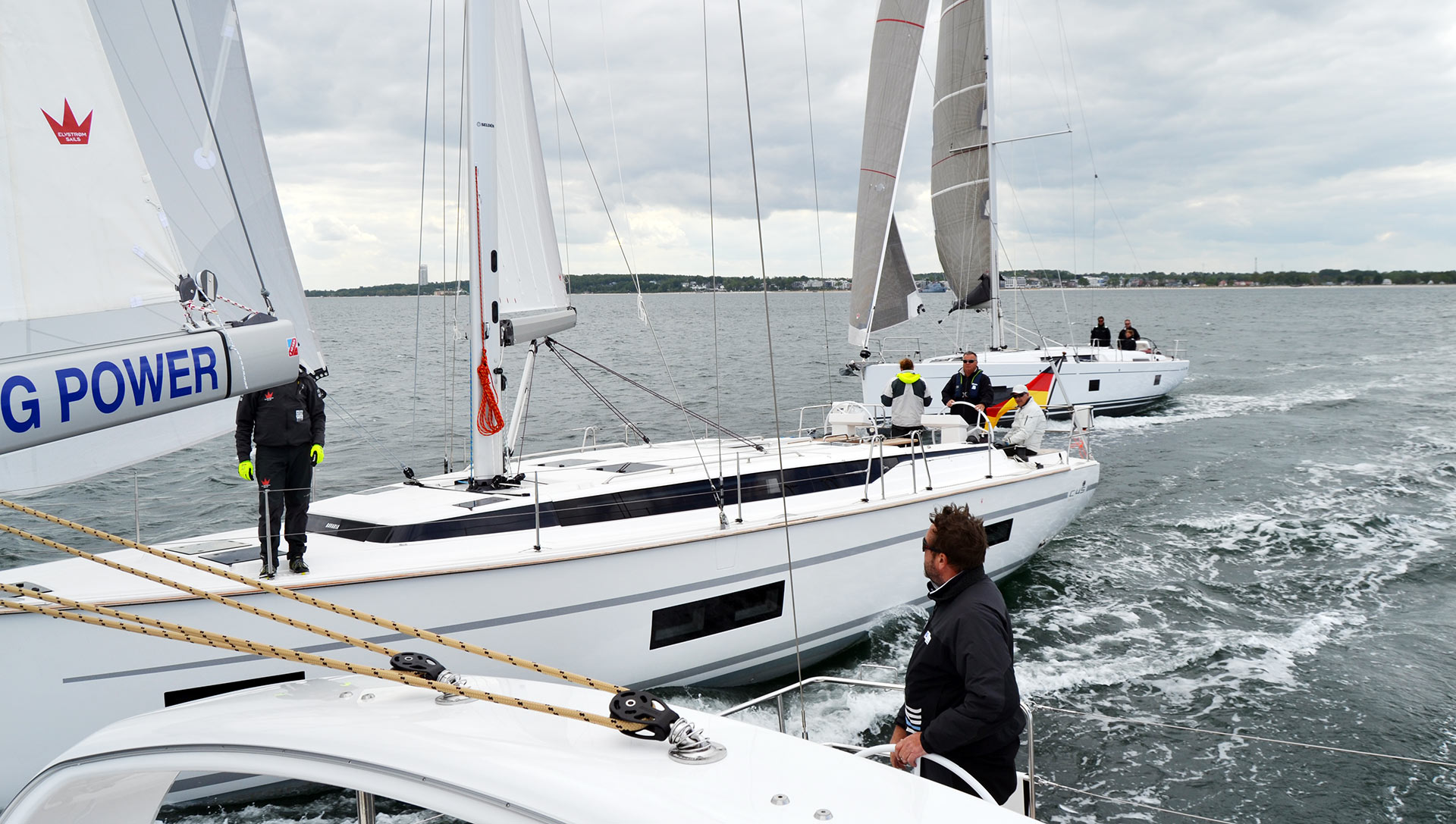
In the end, we sailed next to each other back to port after an exciting 7 hours day out sailing. It was both thrilling (as Fridtjof and Tim were trying to provoke our Oceanis to broach – but failed, causing a hearty praise for the sailing abilities of our yacht) and interesting to witness how a yacht test was conducted. And that was only just the beginning – we´ve had two more days to come! On the second day (which I couldn´t attend because I test-sailed another arrival to our fleet, the brand new Oceanis 30.1 they conducted the testing under engines and – as the wind dramatically dropped – light wind sailing with Gennakers . Third day was spent almost solely at the jetty with the crew measuring all berths, cabins and looking at the internal details of the boat. Amazing.
Can a magazine´s yacht test be helpful?
So, in the end, I really do not know what the outcome of this three-day test will be. But will the article help a future owner to decide for which yacht he should go? I think yes and no. As Fridtjof was saying: “The article will try to paint a full picture of the general package of the boat.” For sure, a certain objective assessment of the boats can be assured by the fact that three editors tested by their own and discussed their findings. In terms of decision-making, such an article is indeed very helpful because a test like this, with a six person-crew working three full days to gather all sorts of information must and will cover a great range of items.
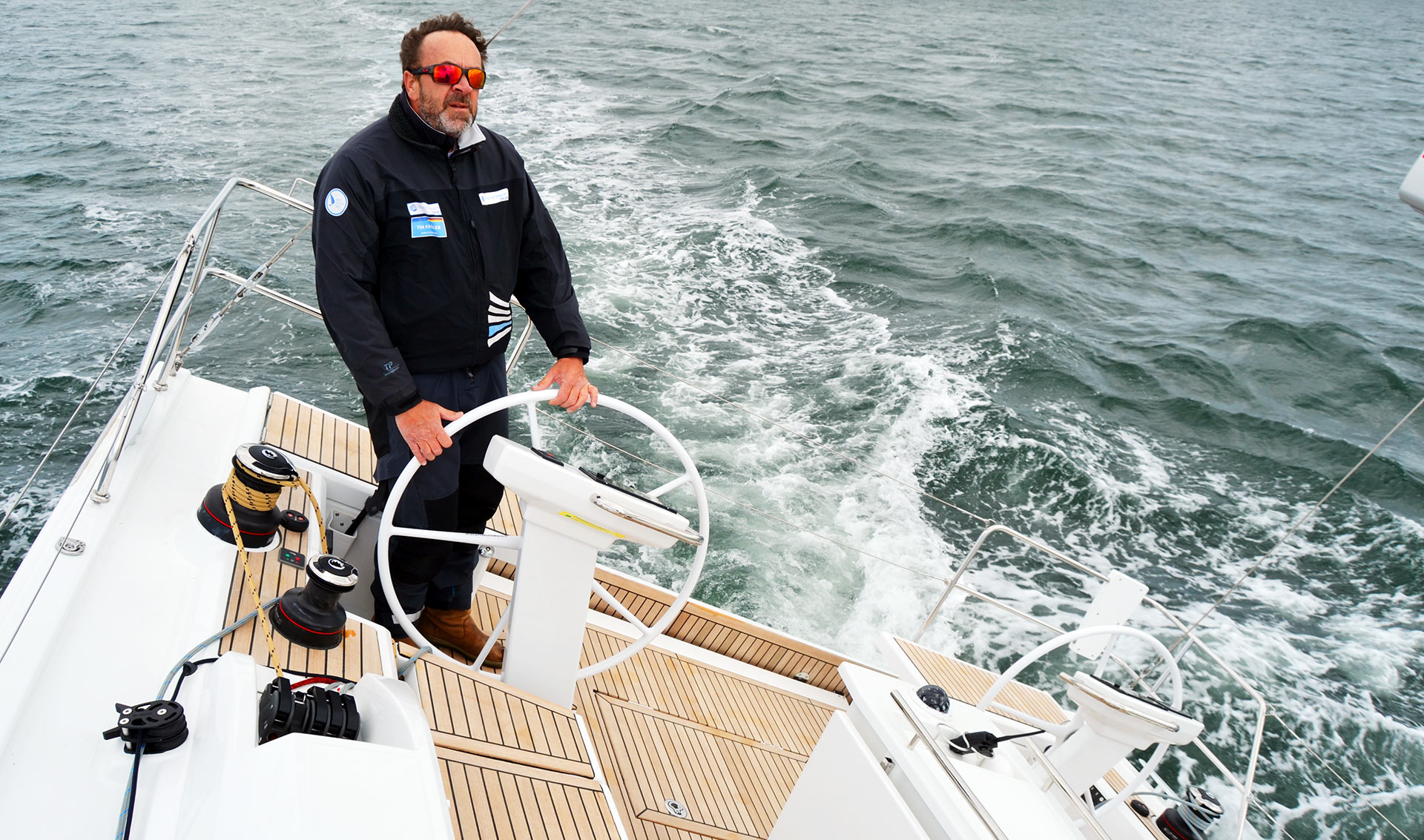
But as Tim Kroeger told me: “In the end each buyer or owner-in-being comes with his own set of demands. He dreams his own dream, he brings with him his own set of skills and this makes his boat a different one from maybe another client.” In this matter, a yachting magazine´s test can just be one step. “Buying a boat is a process”, says Tim: “Clearly, magazines provide help but sailing the boat by himself and getting a feeling for how it is sailing, how it is behaving in harbours and – of course – if you are feeling comfortable with its interior can only be found out by physically visiting the yacht: Either on a boat show or, best, when sailing by yourself.”
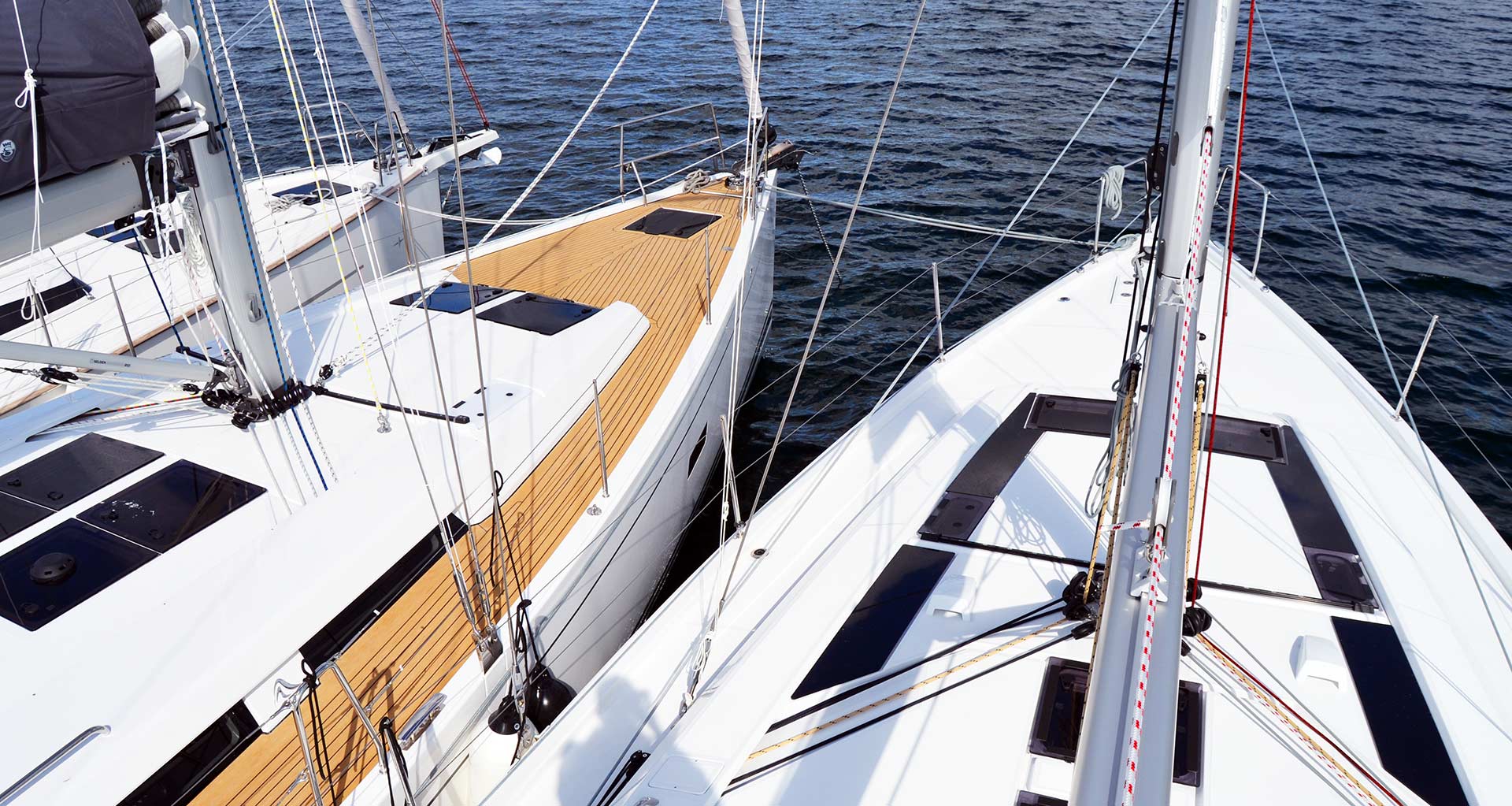
We conclude the three-day session with a cold beer on the jetty and congratulate ourselves for the perfect weather situation and – at last – for three days of fun whilst sailing our yachts. I am sure the outcome will be a great article and I will most certainly hold this very article very dear – now knowing what efforts had been taken to execute this test, how many people worked for three days (and days to come in the office) to gather information, shoot great pictures and crawled the boats to provide their readers with a proper test. Plus, for myself, I learned a lot for my own yacht tests which you, dear reader, may be experiencing in my articles to come as well.
You might also find interesting to read:
How it´s made: A life jacket for children
Tim Kroeger on yacht racing and how to tackle it
Finest aluminium yachts made in Germany

PRESTIGE F-Line 5.7, the evolution of the species
The PRESTIGE F-Line 5.7 introduces a concept, a cruising experience, and living spaces that are truly innovative, designed to meet the new expectations and aspirations of high-end yachting enthusiasts. The second model of the new
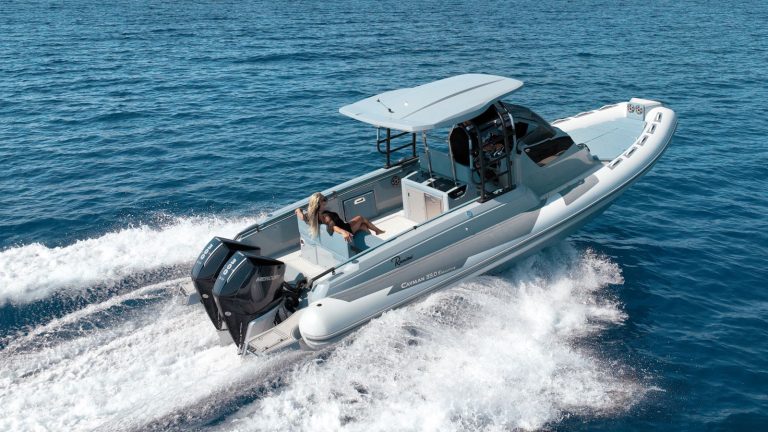
Ranieri Cayman 33.0 Executive, a breath-taking test
The Ranieri Cayman 33.0 Executive is the new RIB that will be officially presented at the Cannes Yachting Festival 2024 and will complete the range offered by the shipyard, which starts with the Cayman One,
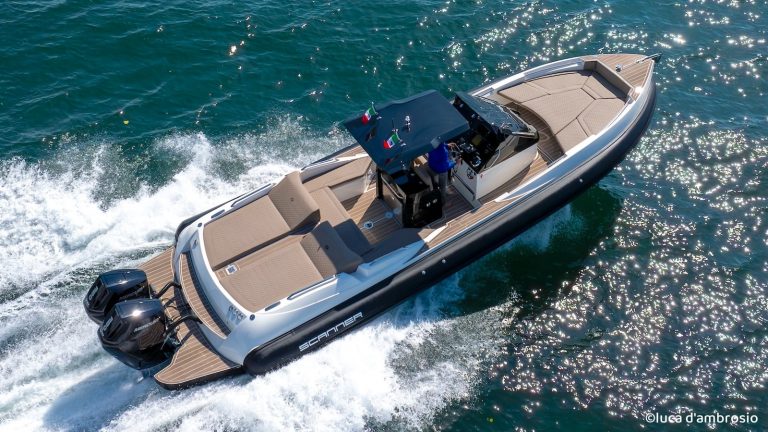
Scanner Envy 1100 T-Top: flying at 50 Knots with the outboard version
Fast and elegant—these are the two adjectives that best describe the new Scanner Envy 1100 T-Top, which, exclusively for The International Yachting Media, we had the chance to test in its outboard version. Equipped for
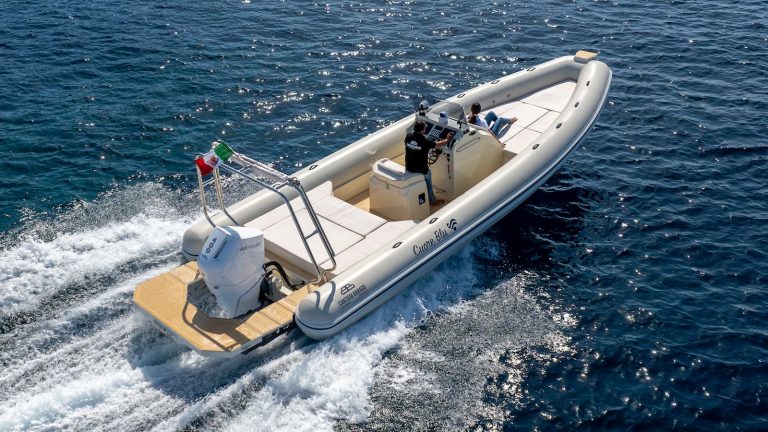
Cantieri Barago: on the Spargi 9 we tested the new Mercury joystick for single-engine systems
Cantieri Barago is a very unique boat builder. Based in La Maddalena, it is known for manufacturing highly seaworthy inflatables that can handle any weather conditions—a quality that is almost a necessity for those living
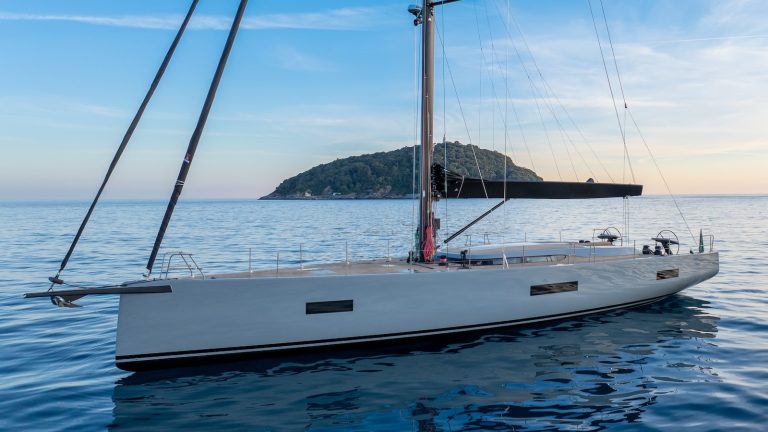
ICE 66 rs: here’s how perfection is made. First sailing impressions and exclusive images
ICE 66 rs: boat tour and first sailing impressions It is not possible to approach a vessel of this caliber without first considering its genesis. Presented in mid-2021, when the world was still in the
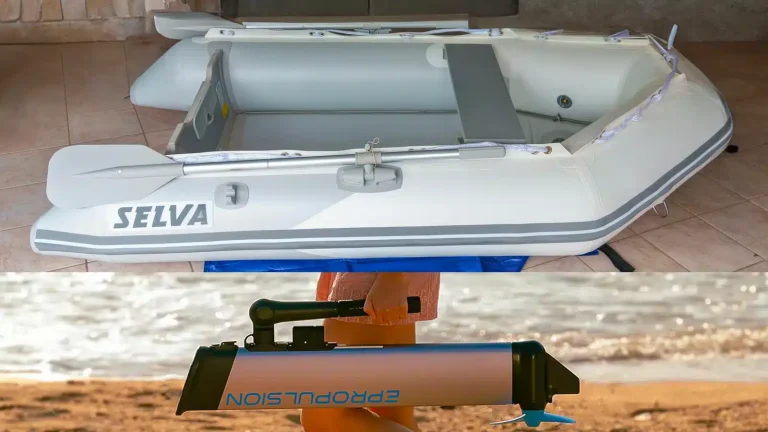
Selva T 230 VIB and ePropulsion eLite: the test begins
Selva T 230 VIB ed ePropulsion eLite: the test begins. It’s no surprise that a tender and an outboard engine are two indispensable accessories. Inseparable companions of our summer cruises, they allow us to disembark,
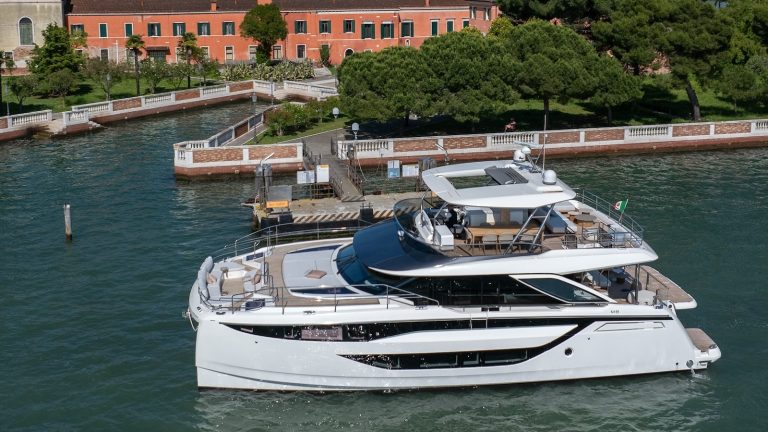
Prestige M8: first-class navigation from Monfalcone to Venice
Prestige M8: catamaran or superyacht? Sixty miles aboard a revolutionary boat Our readers are well aware that The International Yachting Media loves to carry out long-distance trials. Indeed, this is truly the only way to
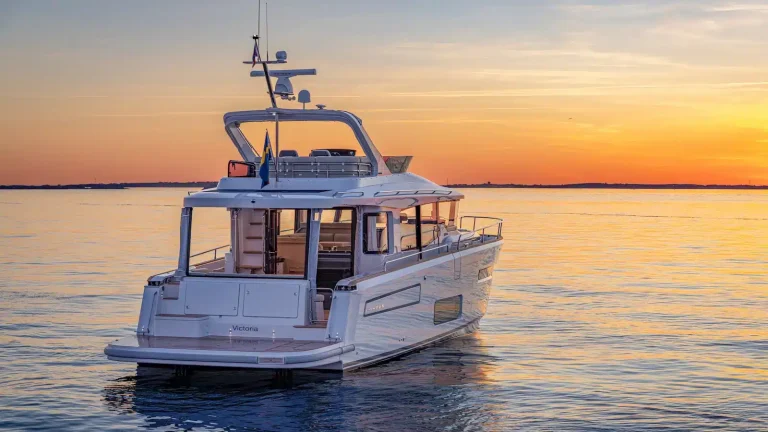
Nimbus 495 Flybridge, sea trial of an out-of-the-ordinary explorer yacht
The brand-new Nimbus 495 Flybridge was one of the most anticipated models on the market. Resulting from the ingenuity of the Nordic shipyard, which best represents the high-end segment of all Scandinavian production, this boat
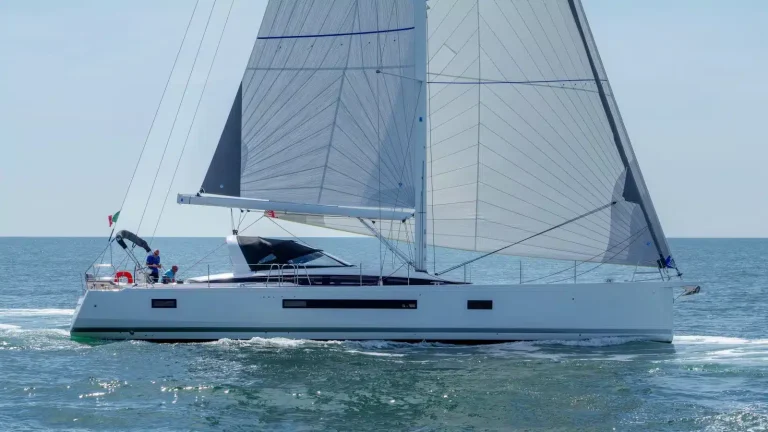
JEANNEAU YACHTS 65, 50 miles in absolute comfort
JEANNEAU YACHTS 65 is one of the models I have wanted to test since I first saw it at the Cannes Yachting Festival. Finally, I have the opportunity because the boat needs to be present
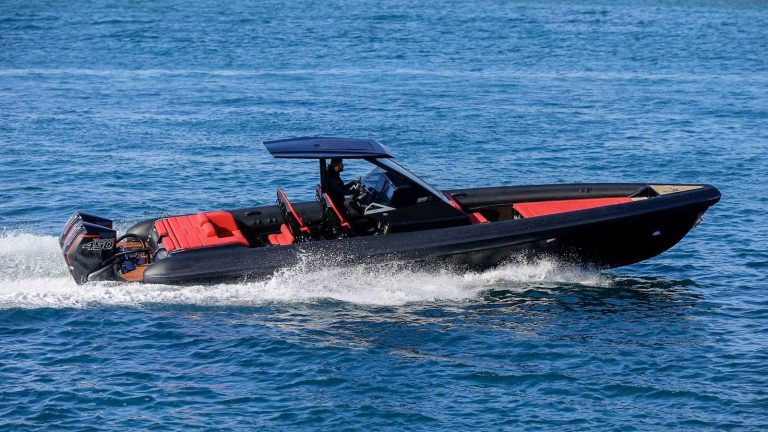
TECHNOHULL 38 GRAND SPORT: at 73 knots it’s pure adrenaline with Mercury 500Rs
TECHNOHULL 38 GRAND SPORT Sea Trial TECHNOHULL 38 GRAND SPORT is a boat that certainly does not go unnoticed. Long, narrow, and a distinctive “total black” look, it immediately invites you to push the throttles
Language switcher
Browse categories.

© 2021 – THE INTERNATIONAL YACHTING MEDIA Designed by BLive Communication
ABOUT YACHTINGNEWS.COM
Yachting News is an interactive multimedia magazine dedicated to the world of boating.
The International Yachting Media is the worlds most widely read boating magazines network. Whit its portal It broadcast its original contents in five languages and in more than 200 countries developing 950,000 views a week. Our web portals are the main source of information for yacht and boat owners, the place where they can find anything about their boating passion.
THEINTERNATIONALYACHTINGMEDIA.COM | SUPERYACHTS.NEWS | YACHT DIGEST
VIRTUAL BOAT SHOW | TUTTTOBARCHE | TOUSLESBATEAUX | TODOSLOSBARCOS
BOATING NEWS FREE APP

To provide the best experiences, we and our partners use technologies like cookies to store and/or access device information. Consenting to these technologies will allow us and our partners to process personal data such as browsing behavior or unique IDs on this site and show (non-) personalized ads. Not consenting or withdrawing consent, may adversely affect certain features and functions.
Click below to consent to the above or make granular choices. Your choices will be applied to this site only. You can change your settings at any time, including withdrawing your consent, by using the toggles on the Cookie Policy, or by clicking on the manage consent button at the bottom of the screen.
Subscribe For Latest Updates
Sign up to receive the best of Yachting News, sea trials, boat review and world premieres .
The only ADVERTISING FREE newsletter
Yachting Monthly
- Digital edition

How to measure your yacht’s stability
- julianwolfram
- July 27, 2020
Naval architect Julian Wolfram uses some able hands, scales and maths to explain a practical way to calculate your boat's stability

Measuring, and then adjusting your yacht's stability can affect when you need to reef
Have you ever measured your yacht’s stability?
Adding heavy cruising gear will change your boat’s stability, so it is worth checking, although the names and terms, such as ‘Dellenbaugh angle’ and ‘metacentric height’, might be initially off-putting and leave you flummoxed.
These measures of a yacht’s stability or stiffness – used to compare one boat to another, or modifications that might have done on board – are more reliable than the crude and common ballast/displacement ratio, and understanding them will reveal the impact on your boat of all the additional cruising gear that has been added.

A simple spirit level can be used to conduct your stability experiment. Credit: Graham Snook
Ballast ratio is a flawed because it takes no account of the shape or depth of the keel, or of how heavily loaded the boat is.
Rather than ballast ratio, a better way to assess the stiffness is by dividing the position of her centre of gravity, as measured from the bottom of her keel (known as KG), by her draught, as this takes into account her both her draught and the centroid of ballast on board.
For any yacht built after 2002 the designer or builder will have calculated and potentially measured the KG for the minimum operating condition and probably for the fully loaded condition too.

You will need to induce at least 3° if heel for this to work. Credit: Graham Snook
This data is needed to do the required Recreational Craft Directive (RCD) calculations.
It may also be available for many yachts from before then if the builder or designer was conscientious.
Interestingly, this information has to be provided, by law, for a commercial vessel in the form of a stability booklet and there is no logical reason why it should be withheld from a yacht owner – but that doesn’t mean you’ll get it.
If you want to compare the stiffness of your yachts with others and can’t get hold of the KG, you will have to do an inclining experiment to calculate it.

Strips of wood are used to ensure accuracy. Credit: Graham Snook
An inclining experiment is required for all commercial vessels, including sailing yachts used for commercial purposes, charter and sail training, and is usually carried out, or at least witnessed by, a ship or yacht surveyor.
The inclining experiment yields the metacentric height (GM) which is a primary measure of stability.
Once you have GM then KG can be found using the hydrostatic particulars that are calculated from the table of offsets or the lines plan.
If you can’t get hold of these then you will have to get a 3D laser scan of the boat, when she is out of the water, and a naval architect who has a stability software package to do the calculations for you.
However, doing an inclining experiment is still worthwhile and, on traditional vessels built by eye or for which the lines and hull offsets have long since disappeared, it is the only option for assessing stability.
How to carry out an inclining experiment to check stability
Anyone can carry out an inclining experiment on their own yacht if they wish to check its stability.
It is done afloat, and simply involves moving weight from the centreline towards the deck edge and measuring how much the boat heels as a result.
The weights can be of any sort – jerry-cans full of water, baskets of old chain or the like.

Inclining weight(s) must be large enough to give at least 3° of heel – five large crew should be good for a 12m yacht, the smaller the boat, the fewer people are required. Credit: Graham Snook
I once did an inclining experiment on a 19m ferro-cement schooner with a weight that consisted of a bunch of students weighed on bathroom scales. It worked well.
Traditionally the angle of heel is measured using a pendulum (plumb line attached to a mast) and recording the offset to the side when the vessel heels.
The pendulum is usually damped using a bucket of water or oil.
Nowadays a device known as a stabilograph is often used which is more convenient.
Alternatively, I have used a long (1,830mm) spirit level successfully when the heel angle is between 3 and 6° and I think this is the cheapest and most practical way for a boat owner to give it a go.

Needless to say calm conditions are necessary to get an accurate measurement and mooring lines should be slack so the boat heels in a completely unrestricted manner.
Ideally the experiment should be done in the loaded condition but with the tanks no more than half full.
The crew are ideal inclining weights and six crew will weigh nearly half a ton (and maybe more in some cases!) and they don’t have to be lifted onto and across the boat.
Mark lines each side of and parallel to the centreline close to the deck edges.
Continues below…

What makes a boat seaworthy?
What characteristics make a yacht fit for purpose? Duncan Kent explores the meaning of 'seaworthy' and how hull design and…

Why you should regularly check your deck fittings
What’s really going on under your deck fittings? Ben Sutcliffe-Davies investigates the hidden weaknesses


How keel type affects performance
James Jermain looks at the main keel types, their typical performance and the pros and cons of each
The crew will stand facing the same direction with feet together, one foot either side of the line and their weight evenly distributed on both feet.
Ideally there should be one long line marked with chalk or tape on each side of the boat.
That may not be possible, however, and two or more lines may be needed; in which case you will have to note who stands where, as the product of each weight and its distance from the centreline is needed in the calculation.
Start by weighing each of the crew in turn on an accurate set of bathroom scales.
Then put the long spirit level across the cockpit with both ends supported so it is level.
Note the distance between the points of support (x mm).
You should be on the centreline when you are checking the level.
Get the crew on board and along the centreline to start with.

The heel of a yacht has historically been measured using a pendulum. Credit: Richard Langdon
Now get them all to take up positions on one side of the boat and carefully chock up the end of the spirit level so it becomes horizontal.
Pieces of plywood and plastic packers down to 1mm in thickness can be used as you need to measure to the nearest millimetre how much you have chocked up the end of the level (y mm).
Ideally the heel angle will be between 3 and 6° and you will have chocked up the end of the spirit level by at least 100mm.
Take the average of the values as the best estimate of GM. It should be accurate to 1 or 2%.
Typical values of GM range from about 0.8m for a 6m coastal cruiser rising to 1.5m or more for an ocean-going 12m yacht.
Read about what makes a boat seaworthy here
Wide hulls with little freeboard should have higher values; any significantly below this range should give cause for concern.
Knowing GM allows the Dellenbaugh angle, to be estimated.
The heeling arm is the distance between the centre of effort of the sail plan and the centre of lateral resistance of the hull and keel.
These can be estimated from a profile drawing, showing the keel and sail plan and worked out using known measurements.
Once calculated, for a 12m long boat a value of 12° would be considered stiff and 18° tender whereas for a 6m boat 18° would be considered stiff and 26 degrees quite tender.
For those who wish to learn more about this I recommend reading Principles of Yacht Design by Larsson, Eliasson and Orych.
How to measure the stability of your yacht
First you have to wait for Mother Nature to give you a calm day: any wind on the rigging could skew the measurements and drive you mad while you’re trying to get the level correct.
Also consider where you’ll do the test; while it is possible to do this on a mooring, the shelter of a marina is best for accurate results.

You will need to weigh crew to help with your calculations. Credit: Graham Snook
You’ll also need weight: passers-by, friends or relatives will do as long as they can spare you 10 minutes.
If not, jerry cans of spare fuel and water, sails, dinghy and liferaft will be needed.
The bigger the boat, the more weight you’ll need. You’ll also need a spirit level – the longer the better.
If it isn’t long enough to go across the cockpit seats of coaming, use a flat bit of wood long enough to span the gap.
1. Marking and measuring

You need to mark the centreline. Credit: Graham Snook
Marking the centreline on deck, we used masking tape, but a pencil or chalk line would do the trick. Then tape another line parallel to the centreline on deck, remembering to allow room for feet on the outside of the line.
Measure the distance from the centreline to the deck line. Use this measurement (d) to mark a second line on the opposite side. The last measurement you will need is the distance between the supports of your spirit level (x).
2. Prepare the weights

Weights need to be lined up along the centreline. Credit: Graham Snook
Next weigh your helpers or equipment to act as weights – a set of bathroom scales is ideal for this, whether for people or heavy objects. Slacken your mooring lines so they don’t affect the way your yacht heels.
Line your weights on the centreline mark and ensure the spirit level is showing your yacht is lying flat in the water. You have to remain on the centreline in the cockpit.
3. The experiment

You need to average the GM figures for both calculations. Credit: Graham Snook
Now move your crew or weights until they are over the deck line; people should stand with one foot either side of the line, weights should be piled up as best as possible. Now pack up the end of the spirit level to bring it level again, then take a note of the thickness of the packing to the nearest millimetre. Repeat the experiment with the weight on the opposite side. Finally, average the GM figures from both calculations.
For all the latest from the sailing world, follow our social media channels Facebook, Twitter and Instagram .
Have you thought about taking out a subscription to Yachting Monthly magazine?
Subscriptions are available in both print and digital editions through our official online shop Magazines Direct and all postage and delivery costs are included.
- Yachting Monthly is packed with all the information you need to help you get the most from your time on the water.
- Take your seamanship to the next level with tips, advice and skills from our expert skippers and sailors
- Impartial in-depth reviews of the latest yachts and equipment will ensure you buy the best whatever your budget
- If you are looking to cruise away with friends Yachting Monthly will give you plenty of ideas of where to sail and anchor

- Apr 29, 2020
How to Test Drive a Boat or Yacht You Want to Buy
By: Richard Crowder

Taking a test drive on a boat you want to buy is always a thrill and often a bit nerve-wracking. Having a plan and knowing ahead of time what you want to accomplish will serve you well in the ultimate enjoyment of your powerboat in the years ahead.
By the time you're ready to test drive a boat, you will hopefully have spent time on board with the people in your life that will be on board ninety-nine percent of the time. That normally means just yourself along with perhaps your spouse, your best boating/fishing/watersport friend, and/or your immediate family.
You should have already determined that the general layout and purpose of the boat , its amenities, seating and/or sleeping and/or entertainment facilities are sufficient and accommodating for the needs of this immediate group that will time on board with you. If any of these items are not suitable, then it’s no use wasting your time or the seller’s time going for a test drive.
In addition to the above, you should also have determined that you are satisfied with the structural soundness of the boat’s construction by means of a hull survey from a recognized and qualified marine surveyor. You should also have determined that you are also satisfied with the boat’s mechanical and electrical systems by means of a mechanical inspection by a recognized and qualified marine technician. You should also have checked with your insurance provider to determine under what conditions they will insure the boat.
In other words, by the time you actually go for your test drive, you should know that all the features and conditions of the boat are acceptable for the price being asked, and that if the test drive is acceptable to you, that you will go ahead with the purchase. Based on the pre-determined features and condition of the boat, you have agreed with the seller that if the features operate as expected on the test drive, and if the boat operates and handles as described by the seller, you will go ahead with the purchase following a successful test drive.
This also means you have pre-arranged how you will pay the agreed price following the test drive. The test drive should be the last item on your boat purchase checklist . If all the other items mentioned above are not in place and pre-agreed with the seller, then you will be wasting your time and the seller’s time by engaging in a test drive which, depending on the complexity of the boat, can be very time consuming.
So now, finally, the boat is in the water and you and preferably only of your boating companions climb aboard. I am recommending a maximum of one other person come along for the test drive. The more people on board with you, the more difficult it will be to concentrate on achieving your objectives of properly assessing the boat. Ask the person with you to listen and observe carefully on your behalf in case you later forget anything and need help remembering details.
The only time you may want more for the test drive is if you normally have that many people on board when operating the boat. And this would only be if you are concerned that the quantity or arrangement of the seating may be inadequate, or that the boat may not perform properly with that many aboard, i.e. to pull up waterskiers or wakeboarders or to get onto plane and cruise at a reasonable speed.
You will have hopefully asked the seller beforehand not to start the engine before arrival so it is cold when you get aboard. Only you and the seller should get aboard and tell anyone else to stay on shore for the moment. Before touching anything else, access the engine compartment and check that the engine is indeed cool to the touch. In the case of an outboard, remove the cover.
Check for any signs of oil or water leakage or any indication it has been recently wiped clean. If an inboard or sterndrive, check the bilge area and note the condition and cleanliness. Check the oil level and condition on the dipstick if a four-stroke engine. Assess the seriousness of any other visible anomalies as indicated on your mechanical inspection results.
Be assured there is sufficient and current safety equipment on board as required by law. Turn the batteries on (if on a switch) and run the blower (mandatory on all but outboard powered boats) for the required two minutes prior to starting the engine. Once the engine is started, check for smoke or a film of oil or gasoline on the water behind the boat. If you see any, make a note and check with a technician as to probable cause and remedy.
Now, with the engine warming up, check the function of all switches on the dash to ensure all pumps, lights, horn, accessories, etc. are working properly. All required safety items at least must be working properly before you will be able to use the boat. Check that all instrumentation and navigation electronics are working properly. Any repairs required for any electrical malfunctions could prove costly. Throughout the test drive, make notes of any problems for later reference.
Now anyone else you brought along can help you untie, cast off, and get aboard. The seller may request to drive and control the boat initially especially if you are unfamiliar with the size or type of boat or the body of water. This is good as you now have an opportunity to observe the seller’s actions and reactions and to ask lots of questions.
Take this opportunity to observe the accuracy of the instruments and to “feel” the boat’s reaction to the water conditions as well as to listen intently for any untoward hull or mechanical sounds. These sounds may include banging, rattling, squeaking, or groaning from the hull and scraping, grinding, clunking, ticking, or vibrations from the engine or drivetrain. All of your senses should be on full alert. Do you smell anything you are concerned about?
When you get the chance to drive, sit in the driver’s seat and relax, observe, and think for a minute. Is the seat comfortable? Can I see forward through the windshield? Can I see out the sides and out the back? Does the steering wheel feel to be in a comfortable position? Can the seat and/or the wheel be adjusted to my liking? Is there too much reflection on the windshield from the dash? Can I easily observe the instrumentation? Do the engine controls fall readily to hand?

Now stand up. Can I stay standing comfortably between the steering wheel and the seat? Can my hands still comfortably reach the wheel and the controls? Can I still see the instrumentation? Can I still see out forward, side, and aft? If there is a forward flip-up seat bolster, does it offer proper support and fit me effectively? Do any of the fixed or canvas enclosures restrict visibility?
Now sit back down in the driver’s seat. Ensure there is no other boat traffic close at hand in any direction. Test the trim system for the drive that it is functioning properly and its action recorded on the trim gauge if any. Slowly move the controls from neutral into forward at idle. There may be a very brief clunk or grinding noise that is expected from cone clutch or engaging gears depending on the drive system, but going from neutral into forward should not create a sudden lurch. If so, the idle speed may be set to high or there could be another problem.
Ensure that the drive unit is fully trimmed down and once underway at idle observe the handling of the boat. Is the steering free but not too loose, and not too much slack on-centre? Then move the throttle slowly forward and repeat the above. Does the throttle move freely? If lots of water around you is available and while at slow speed, move the steering wheel slowly lock to lock. Is the steering smooth and easy throughout the range? Are there any noises like clunking sounds from the drivetrain?
Now point the boat straight ahead, ensure that there is no boat traffic close by and that your passengers are seated and prepared for the next step. Proceed to move slowly but firmly to full throttle and move the boat up onto plane. Does the engine respond positively to full throttle application and accelerate the boat smoothly? Do you need to apply trim tabs (if the boat is so equipped) to assist in getting up and onto plane? Can you properly see ahead while the boat is coming up onto plane?
Once you are up onto plane, throttle back until you find a comfortable and economic cruising speed. This is usually the minimum speed that will hold the boat onto plane without accelerating and without dropping off plane and causing the bow to ride too high.
At this point you may choose to trim up the drive until you feel the hull is running at an efficient angle. You may have to add throttle to hold the boat onto plane and/or you may want to add a bit of trim tabs to bring the bow down. It’s called “finding the sweet spot” and it may take some time after you actually own the boat to experiment and find the most efficient and most comfortable cruising speed and boat attitude. The point is though, are you satisfied with the cruising speed and the attitude (running angle) of the boat? This is where you will be spending a considerable amount of your time aboard.
Until this point you have hopefully been running in a straight line to properly assess the boat’s performance on plane and its optimum cruising speed. Now you want to assess the boat’s performance under normal usage involving different manoeuvres. Check all around to make sure you have no nearby boat traffic and, assuming you have reasonable and acceptable water conditions for the size and nature of the boat, start making long sweeping turns in both directions. Does the boat respond smoothly? Is it holding the angle of the turn or is it slipping or jerking? Is the steering easy to work with and not hard to move? Do you have good visibility throughout the turns?
If the water you have so far been running is representative of the conditions you would normally expect when you own the boat, then you have assessed how the boat handles in terms of noise, wave handling, and comfort and whether that is up to your expectations. If the water so far has been smooth then continue those sweeping turns back into and through your wake to assess the boat’s handling of rougher water conditions. You need to do this coming from both directions into your wake and preferably at different angles too.

Now straighten the boat out again and, as long as the water conditions allow it for your safety and you are experienced enough to do so, slowly take the boat up to full throttle and top speed. Listen and observe to determine that the boat is operating as it was designed and without over-revving, ventilation of the propeller, or exhibiting any signs of hull instability.
Now you can slow down and head back to dock. While at cruising speed and if at all possible, run straight broadside to any prevailing wind and waves to assess the rolling or tilting of the boat and whether the result is acceptable. Along the way, you can also assess the operation of the entertainment system, navigation electronics, depth and/or fish finder, etc. If it is a waterski or wakeboard or wake surf boat, check out on board electronic aids as well as optimum wakes at optimum towing speeds.
Once you get back near to the dock, with the boat at rest, move the controls from forward into neutral and then into reverse and back through neutral again two or three times to assess that docking, which involves these movements, can be accomplished smoothly. Once tied up with the engine turned off, check the bilge area and around the engine and drive unit for signs of water, gasoline, or oil. Check the oil dipstick again for quantity and quality. At this point you should check that the outboard or sterndrive trim works throughout its range, including the trailering position, and properly records this range on the trim gauge.
Now you can examine the condition of the upholstery, any canvas, storage compartments, etc. Check the operation of all additional accessories you may have missed on your initial inspection including pumps, water systems, VHF radio, bilge alarms, livewells, refrigerators, toilets, and in the case of cruisers, all galley appliances, electrical systems, generator, anchor windlass, thrusters, washdowns, etc.
Ensure you know how to work these items and where the controls are located, and where tables, support posts, and spare cushions may be stored. Also ask for any manuals for the boat and its accessories, as well as any additional keys or fobs, remote controls, etc.
If all of the above meets or hopefully even exceeds your expectations then proceed to complete the purchase. Congratulations. You are now a boat owner.
Recent Posts
12 Country Songs to Add to Your Summer Boating Playlist
Boat Driving Statistics That Can Save Your Life
What is AIS and How Does it Work?
3 comentários
Great post. Definitely this one of the informative and useful post to me. Thanks for the share. Top Boat accessories with the best quality of stainless steel. If you want to buy boat accessories with great quality then click the Cool boat Accessories
WOT, wide open throttle?
Take the throttle to WOT for 5 minutes and observe the engine temperature, and see if it overheats. Maybe the propeller is over pitched, maybe the engine cooling system is plugged. Maybe the boat is under powered.

Meet the Man Doing The Great Loop on a $300 PWC

Yamaha Reveals Four New JetBlaster Waverunners for 2025

Man Sets 'Great Loop' Record at 19 Days, 19 Hours, 50 Minutes in Quest to Raise Funds for Cancer Research

The 'Breezy Sea' - How A Refitted Lobster Boat from New Brunswick is Changing Lives on a Small Island in Haiti

Is This the New Tesla of Ski Boats?

Michael Jordan Adds Another 'Catch-23' to His Fishing Fleet
Test special
Yachting World
- Digital Edition

Y Yachts’ Y7 review: This powerful carbon cruiser is guaranteed to excite
- Toby Hodges
- March 5, 2020
Michael Schmidt’s powerful new Y7 combines genius ideas with a keep-it-simple theme, says Toby Hodges
Product Overview
Manufacturer:.
What is your idea of simple sailing? To a wooden yacht enthusiast it may be the pleasure of hand hoisting and trimming sails via block and tackle alone, where an owner of a modern glassfibre yacht might baulk at the amount of upkeep timber demands and prefer the ease of push button sailing.
Others might look back whimsically to their youth and the joy of simply dragging a dinghy down the beach and sailing without any maintenance or financial woes.
Michael Schmidt ’s latest creation is his solution to simple sailing at the luxury end of the scale. The decorated sailor who founded Hanse Yachts believes in a keep-it-simple philosophy with his models, which you may find hard to believe when looking at this new 70-footer and the levels of technical complexity that must lie beneath its carbon fibre/epoxy skins.

We tested the Y7 off Mallorca in 7-12 knots. Photo: Nico Krauss
But having sailed the Y7 in precisely the light wind conditions for which it was designed, and felt the thrill of helming a perfectly balanced, potent and contemporary fast cruiser, I can vouch that it does have a theme of simplicity, which becomes dangerously enticing.
“Sailing fun is made possible by a simple ship that has been reduced to the bare essentials without sacrificing comfort,” Schmidt believes. We’re not talking a yacht stripped to engineless minimalism here. The Y7 is, to all intents and purposes, a scaled-down superyacht , which has been kept approachable, performance-oriented and comparatively easy to manage.
I quote Schmidt not simply because he is the founder of the company, but because he is a veteran boatbuilder, sailor and visionary of the industry. Having built up and then sold Hanse Yachts, and extensively cruised its largest model at the time, the 630e, he searched fruitlessly for a larger, lighter boat that could better harness the softer breezes typically found in the Mediterranean.
Article continues below…

Video: the Brenta 80DC, Hanse founder Michael Schmidt’s ultra fresh carbon cruiser
From the eye-catching paintjob to the novel deck design, to the sensational interior and the full carbon build, the Brenta…

Advanced Yachts A80: Lightweight luxury cruiser can sail in the lightest breeze
A multitude of shiny new yachts drifted across the Bay of Cannes, like a painting of a seascape reflected in…
Michael Schmidt Yachtbau, now Y Yachts, is the brand of luxury carbon cruisers he created, a German firm that aims to use the best technology available to simplify the sailing. Schmidt also believes a yacht needs aesthetics that will distinguish it from the pack.
This philosophy underpinned his first model, the Brenta 80 (now Y8). Schmidt has since cruised that test boat, Cool Breeze , thousands of miles. And while many reportedly liked that concept and design style, they found it too large for their needs.
‘A 70ft yacht you can sail alone’ became Y Yachts’ target. The result is a fast cruiser with no backstay(s), a self-tacking jib and winches and lines that fall to the hand of the helmsman.

Toby helms and trims from the leeward deck. Photo: German de Soler
The design echoes the style of the Y8 and sees Schmidt maintain his penchant for high topsides (from his Hanse days), combined with a flat, low coachroof. Schmidt doesn’t like having to rely on crew and typically sails two-up.
Nevertheless the beamy and voluminous Y7 includes a crew cabin within the interior (rather than stuffed in the forepeak), with private access to the cockpit.
Bill Tripp was tasked with targeting lightweight performance to ensure the boat would offer enjoyable sailing in single figure windspeeds. A key attribute of the Y7 is that it shouldn’t need to motor in light airs.
That said, it can motor very efficiently thanks to the inclusion of two engines; Schmidt values low fuel consumption, good manoeuvrability and systems redundancy.
Carbon construction
Carbon sandwich construction with an epoxy outer skin results in a moderate/light displacement of 29 tonnes and a good balance of impact protection and noise control. Although Schmidt built some of the earliest carbon race yachts, he now subcontracts hull and deck moulding to specialist lamination yards in Poland and Slovenia, then fitting out in his new 3,000m 2 facility in Greifswald.
The structural work and finish of the first Y7, Bella , is certainly to a high standard, and the sub-€2m starting price for this 70ft carbon composite cruiser explains the appeal of the new design and demand to see it in action. The second hull has been handed over, the third is in build and the yard is now set up to produce one boat every four months.

The Y7 has similar styling and features to the Y8, including the high freeboard and low, flat coachroof. Photo: Nico Krauss
The price is a significant factor. The Y7 represents is a lot of carbon yacht for the money. At this price point, potential buyers might be tempted to compare it to a large semi-production cruiser such the CNB 76 or Euphoria 68 . However, those who are looking for comparable performance would need to look at lighter composite yachts – and the Swan 65 , for example, costs another €1m.
Simply seductive
Bella certainly looked very much at home nestled among the superyachts at Port Adriano marina in Mallorca. The flat coachroof was adorned with sunbeds and a table and chairs were set up on its large flush foredeck.
The large bimini shading it hung from the mast, forestay and shrouds – a clever idea to use the foredeck to create a shaded area away from dock. Bella also has a removable cockpit bimini, mounted on four carbon posts.

30º aft swept spreaders allow for a backstay-less rig. Photo: Nico Krauss
When sail trialling a yacht, you always hope to get the type of conditions for which it is primarily designed. I favour moderate winds to ensure I can get a proper feel for the boat. So I did fret a little as we motored out of the marina and met a sloppy sea and a gentle breeze.
However, that long afternoon and evening we spent under sail proved perfect for demonstrating the Y7’s capabilities, and particularly for appreciating its ability to be able to keep on sailing in light winds.
In just 10 knots of breeze, typical midsummer Mediterranean conditions, we were already heeled and powered-up, sailing at 8-8.5 knots. The modern, beamy hull shape, with a long waterline and generous sail area, all help produce such speeds. The sail area to displacement ratio is a huge 33.4, a figure that confirms this design’s significant power aloft. Consequently, she will need to be reefed early.

Lines are led under deck to winches fore and aft of the wheels. This shows the starboard aft winch with shorepower connections below. Photo: Nico Krauss
The square-top fully battened mainsail has 184m 2 of sail area alone, which could be a lot to handle without sufficient crew. An upgrade to the winch package would be on my option list, as it took an age to hoist this sail from the lazyjacks.
However, the helmsman feels the benefit of this sailpower immediately. Tacking the boat is an addictive, one-person affair. The 30° sweptback spreaders avoid the need for a backstay, and allow the use of a self-tacking jib.
We found more breeze once out into the bay and continued our beat west away from the island. The outboard position of the wheel pedestals helps give the helmsman clear views over the flat, low coachroof.

The huge aft deck raises on struts to reveal an enormous watertight garage for a 3.45m RIB, which is launched using a carbon pole off the boom’s aft end. The design allows the garage to remain sealed when the swim platform is lowered. Photo: Nico Krauss
The helm is generally light, as you’d expect with twin rudders, but with a pleasant increase in weatherhelm when the boat heels and powers up. There is also plenty of grip from these rudders, which are positioned relatively far outboard.
It is less comfortable for crew, however. Such is the beam aft (over 18ft) that it can feel unnerving to cross the cockpit or to stay seated to windward when at a high heeling angle. Comparable yachts of this size tend to have a mainsheet winch plinth with rails or a support/crash bar between the wheels. Y Yachts says it can offer the latter, which is an option I’d certainly recommend.
The long cockpit with split tables has room for eight to sit around, with more space on the large aft-facing seats. The portside seat has access to the crew quarters neatly integrated beneath. The aluminium frames that form the backrests for the cockpit seats are freestanding of the coamings, a clear indication that this boat is aimed at warm weather sailing.

Clear decks with lines led within reach of the helmsman. Photo: Nico Krauss
Push button reaching
I thought the Y7 might be all about the upwind sailing experience, keeping the apparent windspeed up and heel on, but then we hoisted a Code 0 for the long reach back.
At the push of another pedestal button, an electric furler fitted in the end of the bowsprit unleashed an enormous amount of sail (acquired, it transpired, from a Maxi 72). With this code sail set, we picked up pace and were able to match the 7-11 knot wind speeds all the way home.
The single point mainsheet is led forward to the mast and aft to one winch. This arrangement, together with the other sheets and halyards, results in a mass of rope tails in the cockpit. Unusually (and commendably), there are generous-sized rope tail lockers between the winches to keep all these lines from getting too unruly.
The deck is stepped in line with where the guest cockpit meets the sailing cockpit, so there is easy access out onto the sidedecks. Here, the double guardrails reduce to single rails to meet the bulwark and pushpit.
This low rail invites the helmsman to sit right out to leeward and enjoy the clear views forward. However, the wide-open aft deck and low rail do little to promote a secure feeling if you are in the sailing cockpit.
Nevertheless, as I perched to leeward, and with a light hand on the wheel, the sailing was truly memorable, and we footed along effortlessly under the Code sail.

Twin engine controls on one of the large binnacles. Photo: Nico Krauss
Two engines
The Y7 certainly has a slippery hull design – so much so that it was only as we approached the marina that I remembered that the Y7 is fitted with two shaft-drive propellers. Twin Nanni engines were chosen as they are simple to repair, with few electronics, and their relatively small size means the saloon sole and thus coachroof can be kept low and streamlined.
However, problems with the installation on this first boat resulted in unacceptable noise levels, an issue the yard now reports has been resolved. It says all future models will have saildrives.
Under power, the boat doesn’t quite spin on a point like a catamaran – the props are quite close together – but the twin engines certainly aid manoeuvrability and mean that you are much less reliant on the bowthruster.

Bella ’s modern open and inviting saloon. Note the sliding leather handles on the deckhead, which resemble underground train handles – a novel yet practical solution we first saw on the Y8. Photo: Sichtvorteil / Thomas Wilhelmi
Below decks, the styling matches the impressive look of the exterior, and is akin to a designer apartment. In Bella ’s case, it was customised specially for Michael Schmidt. Hull number two is said to have a much lighter, less masculine trim.
Schmidt was inspired by modern architectural designs he saw in Copenhagen, and this is reflected in the feel of the finish, from the choice of fabrics, to the lighting and overall interior shapes.
Smart thinking and styling
Multiple layout options are offered including three or four cabins, and the choice of a central transverse galley or passageway galley aft. Abaft the aft port cabin is a clever, if super-compact, crew cabin, which contains two bunks at right angles to each other, a heads and private access to the sailing cockpit.

The forward cabin with huge island berth. A step up through a watertight bulkhead leads into the generous heads compartment forward. Photo: Sichtvorteil / Thomas Wilhelmi
The semi-raised saloon creates the impression of a huge space. The yacht’s large beam accentuates this by exposing the curves and structures of hull sides. On the test boat the saloon has a wide-open space extending as far as the galley, sited amidships. To help you traverse it, there are sliding leather grabhandles on the deckhead for when moving about.
I like the use of vertical glass coachroof windows, which let in plenty of light without producing too much heat, but to provide better ventilation I would prefer to have more opening portholes and some coachroof hatches.
The galley is relatively compact and is open along the centreline, a layout that is perhaps not ideally suited to life at heel. That said, it boasts a large area of fiddled work surfaces and generous amounts of refrigerated stowage, and the yard does offer the option of a larger, enclosed galley aft, which connects through to the crew accommodation.
A central island berth in the forward cabin suggests this, too, is designed more for use in port than at sea. Hull number two has an offset berth here, which will be more practical at sea.
The Y7 is undeniably a lovely yacht to spend time aboard and one that can be handled with relative ease. The ‘keep it simple’ philosophy is felt mostly in the sailing, trimming and manoeuvring. The helmsman can easily manage lines and controls from the wheel – though would need help with setting, stowing and reefing sails. From the design of the tender garage, the installation of twin engines to a myriad of neat fixtures and fittings, the Y7 is packed with novel ideas, all born out of Michael Schmidt’s enormous experience. Below decks the Y7 feels as much like a luxury apartment as a yacht, and the style can be customised to suit an owner. I loved the exterior and interior design of Bella, although I think the layout is more set up for use at rest than at sea. The contemporary styling is bound to divide opinion. But the Y7 boasts superyacht quality at a size that is properly rewarding to sail. This powerful yacht boasts a level of performance that is guaranteed to excite.

IMAGES
VIDEO
COMMENTS
COMPARISON TEST DECK SALOON YACHTS One topic, very different designs: three current yachts around 40 feet with deck saloon in an exciting concept comparison. Including: Moody 41 DS, Nordship 380 DS and Sirius 40 DS. Part 1: YACHT 18 Part 2: 19/2020. Photo: YACHT/B. Scheurer.
Hier finden Sie eine Übersicht aller Tests von neuen und gebrauchten Yachten des vergangenen Jahrgangs und können diese direkt herunterladen Foto: EYOTY/Rick Tomlinson AMEL 60 Einfaches Handling, gute Segeleigenschaften, beste Qualität und Sicherheit: Das neue Topmodell der französischen Premiummarke Amel kann begeistern.
Yacht-Modelle | Ausrüstung für die Yacht | Reisen & Charter-Ratgeber | Aktuelle Regatta-News und praktisches Segelwissen | Gebrauchtbootemarkt
Boat tests. Indepth yacht reviews and boat tests from the experts at Yachting World - we test the latest and best models from Gunboat, Solaris, Moody and Oyster. to. Showing reviews 1-20 of 202.
Boat tests and reviews on new boats, yachts, and engines with over 3000 videos including factory tours, Boat parts, comparisons, and demonstrations, including speed, fuel burn, ... I am based in Australia and your tests are about the only way I can learn about US Boats, because of your tests I have purchased 3 boats one new a 21' Bayliner ...
Sailing pleasure reduced to the essentials. (Davos, Switzerland)- Michael Good, Yacht.de journalist and reviewer, provided this initial overview of their J/9 "boat test" in Switzerland. Here is what he had to say: "J/Boats in the USA has a new weekender on offer. The concept of the J/9 is very simple, the optics are attractive.
The Garcia Exploration 52's bright, comfortable deck saloon. It is a yacht that seamlessly blends the world of luxury cruising with out-and-out expedition yachting. It invites you to go off the ...
Tell us about mid-sized motor yachts on the short list of World Yachts Trophies 2020.. The Cannes show in 2020 could not be held due to the COVID-19 pandemic. However, the cancellation of the event did not affect the annual World Yachts Trophies Award, which is traditionally presented during the Cannes Yachting Festival. The finalists of the 19th edition of the award are 69 boats from 13m to ...
Chartering the type of yacht you are thinking about buying may be the perfect way to test a yacht works for you before you make the leap. TAGS: How to buy a second hand boat Top stories.
YACHT tv bietet alles aus der Welt des Segelns, von Testberichten zu neuen Jollen, Fahrtenyachten oder auch ausgefallenen, besonderen Booten, über Berichterstattung zu allen sportlich wichtigen ...
Die neue Sonder-Edition der YACHT. Die Sonder-Edition des YACHT-Magazins umfasst Kompakt-Tests von 100 ausgesuchten Segelbooten zwischen 18 und 60 Fuß. Jetzt bestellen! Mit dieser Sonder-Edition der YACHT erhalten Sie ein Kompendium, das seinesgleichen sucht. Das Magazin bündelt Kompakttests von 100 ausgesuchten Booten, die auf dem Markt ...
With more than 3,000 videos — tests, reviews, factory tours and interviews — BoatTEST is the world's largest online resource for new boat research. Please subscribe to our channel to get the ...
Contender 23 Bay Walkthrough and Sea Trial. Contender's newest boat is also the smallest in its fleet. The 23 Bay is a fishing-focused inshore boat with a 300-hp Yamaha. On our test drive, we blazed across Miami's Fisherman's Channel at 62 mph. Take a look. By Charlie Levine Feb 19, 2024. Boat Tests.
The last days one of these magazines, Europe´s largest yachting magazine, the German "Yacht", was conducting a big and costly test. As I am part of the Beneteau dealer´s network our newest member of the fleet, the Oceanis 46.1 was selected to take part. Our fleet has been joined by a Bavaria C45 and the Hanse 458, comprising a three-boats ...
Cantieri Barago: on the Spargi 9 we tested the new Mercury joystick for single-engine systems. August 1, 2024. Cantieri Barago is a very unique boat builder. Based in La Maddalena, it is known for manufacturing highly seaworthy inflatables that can handle any weather conditions—a quality that is almost a necessity for those living.
Measure the distance from the centreline to the deck line. Use this measurement (d) to mark a second line on the opposite side. The last measurement you will need is the distance between the supports of your spirit level (x). 2. Prepare the weights.
X-Yachts X4-9 test: Danish yard strikes a tough balance with hybrid design. April 11, 2019. The X49 is squarely aimed at the no-compromise sailor who wants it all. It combines…. Page 1 of 6. 1 ...
Die Übersicht aller YACHT-Tests umfasst mehr als 50 Jahre Sportbootsbau. Kaum eine Yacht, die in den letzten Jahrzehnten nicht von der YACHT getestet wurde. In unserem Archiv lassen sich selbst vergessen geglaubte Perlen des Bootsbaus wiederfinden. Die im PDF-Format hinterlegte Liste wird laufend aktualisiert und reicht zurück bis in die ...
Croatia Original test. The definitive Yacht Week experience. The original floating festival, with the biggest parties. From £XXXX pp. Trip overview Itinerary The details Reviews Talk to the team. Browse Dates & Prices. About the trip +3 photos. Where it all began. Rated 4.8/5 by Yacht Weekers.
Turn the batteries on (if on a switch) and run the blower (mandatory on all but outboard powered boats) for the required two minutes prior to starting the engine. Once the engine is started, check for smoke or a film of oil or gasoline on the water behind the boat. If you see any, make a note and check with a technician as to probable cause and ...
Benetau First 30. A bang at the start of the trade fair on the Cote d'Azur. Italia 9.98. Powerful performance boat for experienced regatta team on test. 47-metre catamaran. "Artexplorer" is a sailing work of art. European Yacht Of The Year 2025. These are the nominees for European Yacht of the Year. Verlagssonderveröffentlichung.
Yachts Regatta Yacht Market. Premium. Subs. Menu. Test special. Part of Delius Klasing Verlag GmbH. General service. Company Imprint AGB Data protection Contact us Feed RSS Cookie-Settings FAQ Premium. Subscription service. Abo Holiday-Service Change of address Contact us. Media Sales. Contact Person Media-Data.
Fuel capacity : 900lt (198gal) Sail area/displacement ratio : 33.4. Displacement/LWL ratio : 96. Design: Bill Tripp. Standard price: from €1,885,000. Michael Schmidt's powerful new Y7 combines ...